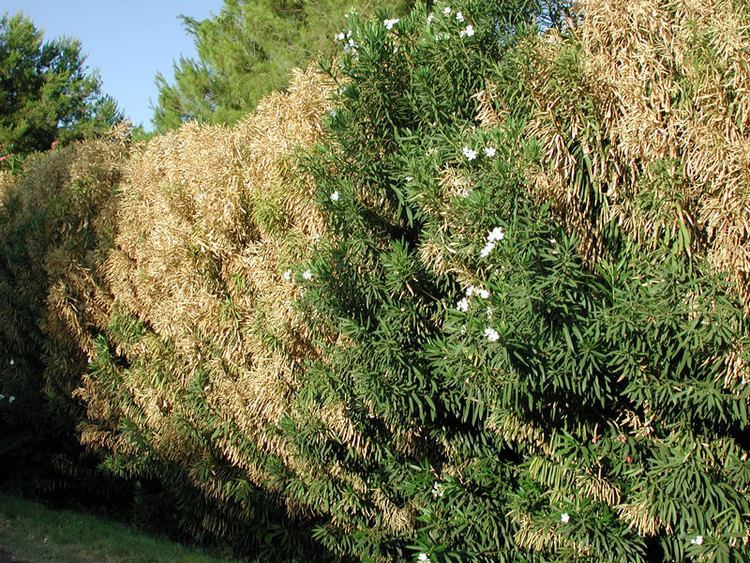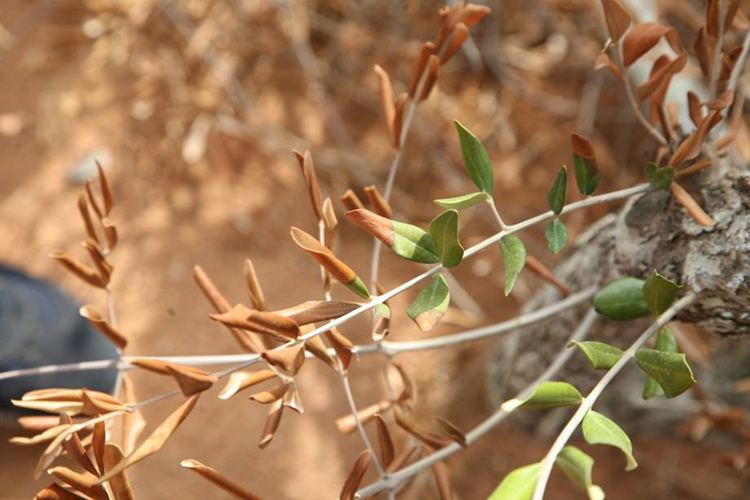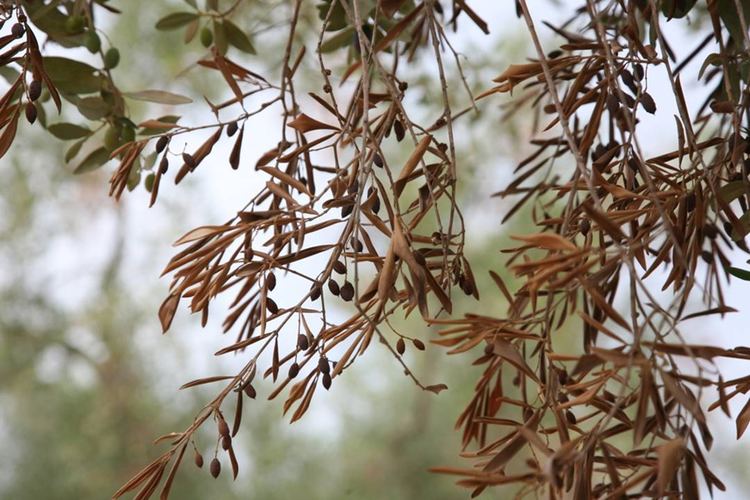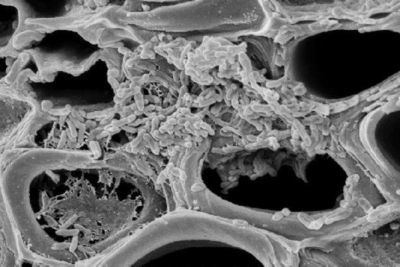Domain Bacteria Family Xanthomonadaceae Scientific name Xylella fastidiosa Class Gammaproteobacteria Phylum Proteobacteria | Order Xanthomonadales Genus Xylella Kingdom Eubacteria Rank Species Higher classification Xylella | |
 | ||
Similar Bacteria, Glassy‑winged sharpshooter, Xanthomonas, Leafhopper, Sharpshooter | ||
Xylella fastidiosa, a bacterium in the class Gammaproteobacteria, is an important plant pathogen that causes phoney peach disease in the southern United States, bacterial leaf scorch, oleander leaf scorch, and Pierce's disease (in grapevines), and citrus variegated chlorosis disease (CVC) in Brazil. In Europe it has attacked olive trees in the Salento area of Southern Italy causing the olive quick decline syndrome (OQDS).
Contents
- Xylella fastidiosa bacteria discovered in wholesale market near paris
- Pierces disease grapevines
- Oleander leaf scorch
- Olive tree decline
- Genome sequencing
- References

Xylella fastidiosa bacteria discovered in wholesale market near paris
Pierce's disease (grapevines)

Pierce's disease (PD) was discovered in 1892 by Newton B. Pierce (1856–1916; California's first professional plant pathologist) on grapes in California near Anaheim, where it was known as "Anaheim disease." The disease is endemic in northern California, being spread by the blue-green sharpshooter, which only attacks grapevines that are adjacent to riparian habitats. It became a real threat to California's wine industry when the glassy-winged sharpshooter (GWSS), native to the southeast United States, was discovered in the Temecula Valley in California in 1996. The GWSS spreads PD much more extensively than other vectors do. It triggered a unique effort from growers, administrators, policy makers and researchers to work together in finding a solution for this immense threat. No cure has yet been found, but the understanding of Xylella fastidiosa and glassy-winged sharpshooter biology has increased much since 2000, when the California Department of Food and Agriculture, in collaboration with different universities, such as University of California, Davis (UC Davis); University of California, Berkeley, and University of California, Riverside, and the University of Houston–Downtown started to focus their research on this pest. The research explores the different aspects of the disease propagation from the vector to the host plant and within the host plant, to the impact of the disease on California's economy. All researchers working on Pierce's disease meet annually in San Diego in mid-December to discuss the progress in their field. All proceedings from this symposium can be found on the Pierce's disease website, developed and managed by the Public Intellectual Property Resource for Agriculture (PIPRA).

There are no resistant Vitis vinifera varieties, and Chardonnay and Pinot noir are especially sensitive, but muscadine grapes (Vitis rotundifolia) have a natural resistance. Pierce's disease is found in the southeastern United States and Mexico. Also it was reported by Luis G. Jiménez-Arias in Costa Rica, and Venezuela, and possibly in other parts of Central and South America. There are isolated hot spots of the disease near creeks in Napa and Sonoma in northern California. Work is underway at UC Davis to breed PD resistance from Vitis rotundifolia into Vitis vinifera. The first generation was 50% high quality vinifera genes, the next 75%, the third 87% and the fourth 94%. In the spring of 2007, seedlings that are 94% vinifera were planted.

When a vine becomes infected, the bacterium causes a gel to form in the xylem tissue of the vine, preventing water from being drawn through the vine. Leaves on vines with Pierce's disease will turn yellow and brown, and eventually drop off the vine. Shoots will also die. After one to five years, the vine itself will die. The proximity of vineyards to citrus orchards compounds the threat, because citrus is not only a host for the sharpshooter eggs, but it is also a popular overwintering site for the insect. Likewise, oleander, a common landscaping plant in California, serves as a reservoir for Xylella.
Oleander leaf scorch

Oleander leaf scorch is a disease of landscape oleanders (Nerium oleander) caused by a strain of X. fastidiosa which has become prevalent in California and Arizona, USA starting in the mid 1990s. This disease is transmitted by a type of leafhopper (insect) called the Glassy-winged sharpshooter (Homalodisca coagulata).
Olive tree decline

In October 2013 the bacterium was found to be infecting olive trees in the region of Apulia in southern Italy. The disease was causing a rapid decline in olive plantations and by April 2015 it was affecting the whole Province of Lecce and other zones of Apulia. The bacterium had never previously been confirmed in Europe. Almond and oleander plants in the region have also tested positive for the pathogen.
The disease has been called olive quick decline syndrome (OQDS; in Italian: complesso del disseccamento rapido dell'olivo). The disease causes withering and desiccation of terminal shoots, distributed randomly at first but which then expands to the rest of the canopy. This results in the collapse and death of the trees. In the affected groves, all of the plants show symptoms. By the beginning of 2015 it had infected up to a million trees in the southern region of Apulia.
By July 2015, Xylella fastidiosa had reached Corsica; by October 2015, it had reached Mainland France, near Nice. On 18 August 2016 in Corsica have been detected 279 focuses of the infection, concentrated mostly in the south and the west of the island.
In August 2016, the bacterium has been detected in Germany in an oleander plant.
In January 2017 it was detected in Majorca and Ibiza.
Genome sequencing
The genome sequencing of X. fastidiosa was realized by a pool of over 30 research labs in the State of São Paulo, Brazil, and funded by this State's Science Foundation (FAPESP).
